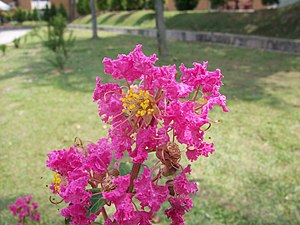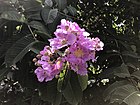Note: This is a project under development. The articles on this wiki are just being initiated and broadly incomplete. You can Help creating new pages.
Difference between revisions of "Lagerstroemia speciosa"
| Line 2: | Line 2: | ||
'''Lagerstroemia speciosa''' is a fast-growing, medium-sized, deciduous, sub-canopy tree. It is produces suckers, usually grows 15 metres tall. The bole is around 60cm in diameter. | '''Lagerstroemia speciosa''' is a fast-growing, medium-sized, deciduous, sub-canopy tree. It is produces suckers, usually grows 15 metres tall. The bole is around 60cm in diameter. | ||
==Uses== | ==Uses== | ||
| − | {{Uses|}}, {{Uses|}}, {{Uses|}}, {{Uses|}}, {{Uses| | + | {{Uses|Diabetes}}, {{Uses|Urinary problems}}, {{Uses|Cracked feet}}, {{Uses|Diarrhoea}}, {{Uses|Abdominal pains}}.<ref name="Uses"/> |
==Parts Used== | ==Parts Used== | ||
| − | {{Parts Used|}}, {{Parts Used| | + | {{Parts Used|Bark}}, {{Parts Used|Fruits}}, {{Parts Used|Leaves}}. |
==Chemical Composition== | ==Chemical Composition== | ||
| Line 48: | Line 48: | ||
==Mode of Propagation== | ==Mode of Propagation== | ||
| − | {{Propagation|}} | + | {{Propagation|Seeds}}, {{Propagation|Cuttings}}, {{Propagation|Division of root suckers}}. |
==How to plant/cultivate== | ==How to plant/cultivate== | ||
| − | <ref name="How to plant/cultivate"/> | + | A plant of the moist, lowland tropics and subtropics, where it is found at elevations up to 400 metres. It grows best in areas where annual daytime temperatures are within the range 18 - 35°c, but can tolerate 6 - 43°c.<ref name="How to plant/cultivate"/> |
==Commonly seen growing in areas== | ==Commonly seen growing in areas== | ||
| Line 72: | Line 72: | ||
<ref name="Leaf">[Morphology]</ref> | <ref name="Leaf">[Morphology]</ref> | ||
| − | <ref name="How to plant/cultivate">[Cultivation]</ref> | + | <ref name="How to plant/cultivate">[http://tropical.theferns.info/viewtropical.php?id=Lagerstroemia+speciosa Cultivation]</ref> |
<ref name="Uses">Indian Medicinal Plants by C.P.Khare</ref> | <ref name="Uses">Indian Medicinal Plants by C.P.Khare</ref> | ||
</references> | </references> | ||
==External Links== | ==External Links== | ||
| − | * [ ] | + | * [http://www.flowersofindia.net/catalog/slides/Queen%20Crape%20Myrtle.html Lagerstroemia speciosa on flowersofindia.net] |
| − | * [ | + | * [https://ijpsr.com/bft-article/a-review-on-lagerstroemia-speciosa/?view=fulltext Lagerstroemia speciosa on ijpsr.com] |
| − | |||
[[Category:Herbs]] | [[Category:Herbs]] | ||
[[Category:Pages without herbs images]] | [[Category:Pages without herbs images]] | ||
Revision as of 14:42, 29 May 2020
Lagerstroemia speciosa is a fast-growing, medium-sized, deciduous, sub-canopy tree. It is produces suckers, usually grows 15 metres tall. The bole is around 60cm in diameter.
Contents
- 1 Uses
- 2 Parts Used
- 3 Chemical Composition
- 4 Common names
- 5 Properties
- 6 Habit
- 7 Identification
- 8 List of Ayurvedic medicine in which the herb is used
- 9 Where to get the saplings
- 10 Mode of Propagation
- 11 How to plant/cultivate
- 12 Commonly seen growing in areas
- 13 Photo Gallery
- 14 References
- 15 External Links
Uses
Diabetes, Urinary problems, Cracked feet, Diarrhoea, Abdominal pains.[1]
Parts Used
Chemical Composition
Common names
| Language | Common name |
|---|---|
| Kannada | |
| Hindi | |
| Malayalam | |
| Tamil | |
| Telugu | |
| Marathi | |
| Gujarathi | |
| Punjabi | |
| Kashmiri | |
| Sanskrit | |
| English |
Properties
Reference: Dravya - Substance, Rasa - Taste, Guna - Qualities, Veerya - Potency, Vipaka - Post-digesion effect, Karma - Pharmacological activity, Prabhava - Therepeutics.
Dravya
Rasa
Guna
Veerya
Vipaka
Karma
Prabhava
Habit
Identification
Leaf
| Kind | Shape | Feature |
|---|---|---|
Flower
| Type | Size | Color and composition | Stamen | More information |
|---|---|---|---|---|
| {{{5}}} |
Fruit
| Type | Size | Mass | Appearance | Seeds | More information |
|---|---|---|---|---|---|
Other features
List of Ayurvedic medicine in which the herb is used
Where to get the saplings
Mode of Propagation
Seeds, Cuttings, Division of root suckers.
How to plant/cultivate
A plant of the moist, lowland tropics and subtropics, where it is found at elevations up to 400 metres. It grows best in areas where annual daytime temperatures are within the range 18 - 35°c, but can tolerate 6 - 43°c.[4]
Commonly seen growing in areas
In open vegetation types, Often coastal areas, In swamps, Along rivers.
Photo Gallery
References
- ↑ Indian Medicinal Plants by C.P.Khare
- ↑ [Chemistry]
- ↑ [Morphology]
- ↑ Cultivation
External Links
- Ayurvedic Herbs known to be helpful to treat Diabetes
- Ayurvedic Herbs known to be helpful to treat Urinary problems
- Ayurvedic Herbs known to be helpful to treat Cracked feet
- Ayurvedic Herbs known to be helpful to treat Diarrhoea
- Ayurvedic Herbs known to be helpful to treat Abdominal pains
- Herbs with Bark used in medicine
- Herbs with Fruits used in medicine
- Herbs with Leaves used in medicine
- Habit - Deciduous tree
- Index of Plants which can be propagated by Seeds
- Index of Plants which can be propagated by Cuttings
- Index of Plants which can be propagated by Division of root suckers
- Herbs that are commonly seen in the region of In open vegetation types
- Herbs that are commonly seen in the region of Often coastal areas
- Herbs that are commonly seen in the region of In swamps
- Herbs that are commonly seen in the region of Along rivers
- Herbs
- Pages without herbs images





